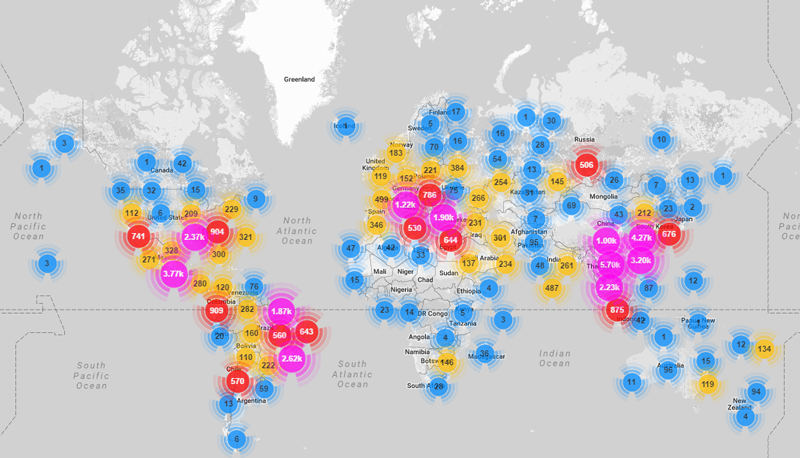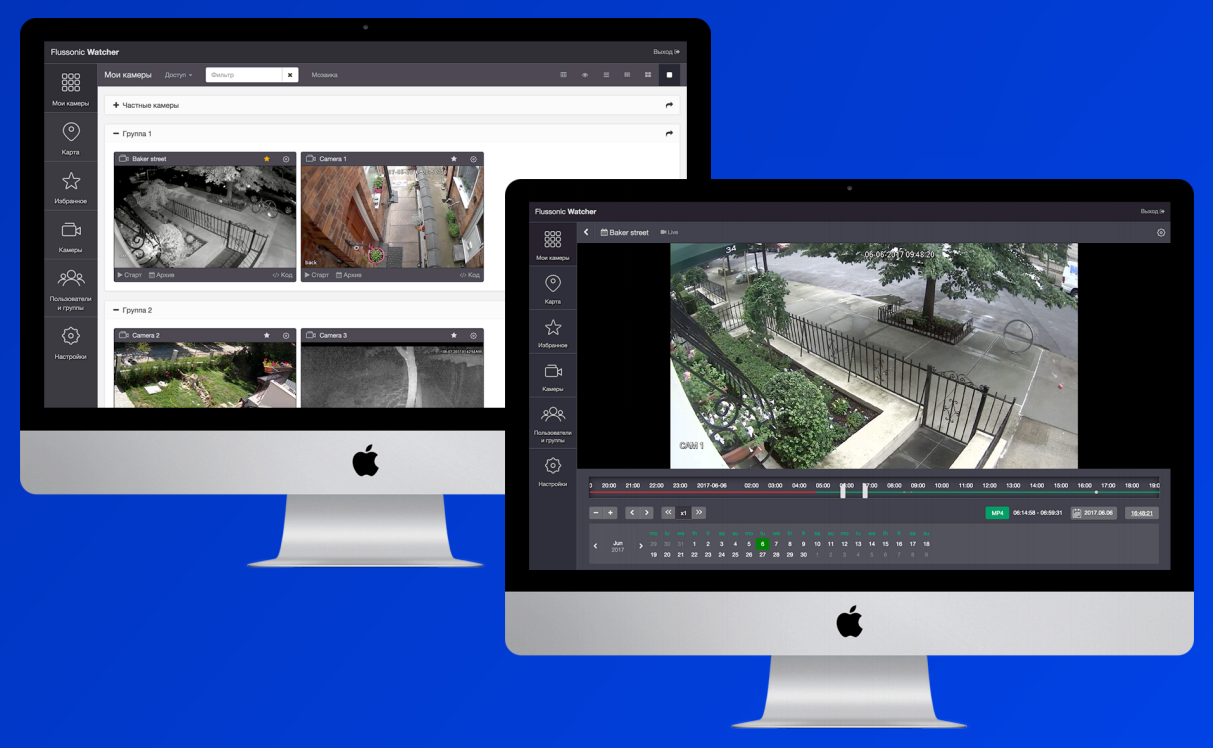Flussonic Watcher for Internet Service Provider
The oversaturated competitive telecom market, cheaper communications and services, increasing service requirements and the burden of the state on the infrastructure of operators lead to the fact that the falling profit of operators does not allow them to grow as before. And someone is completely unwell. In the struggle for user loyalty and increasing the average check, operators have one clear way - to offer their customers additional services.
The three most popular destinations for telecom operators are home and mobile Internet and, of course, digital television. Reflecting on what may be interesting to the subscriber, it is worth paying attention to street, driveway and home video surveillance. The user himself, with all the desire and even for his beloved, will not be able to organize such a service on the scale of an apartment building for a number of reasons, so such a service can become your trump card.

At a minimum, this is illegal, since the housing code requires the consent of all residents to install video surveillance on the territory of an apartment building. In addition, everyone will immediately need access to the cameras, even those who have never thought about this. This can easily put the Internet channel through which the recorder is connected, and this will be the smallest of the problems that you will have ... If an ordinary person wants to hang the camera on a pole in the yard, then more coordination will be required: from installation and summing up to it power up to internet connectivity issues. And who will pay for all this? How to serve?
In addition, all inexpensive Chinese DVRs and cameras with factory firmware do not have protection against hacking and can quickly become part of a botnet, for example, Mirai, and take part in hacker attacks. Here is a map of Mirai infections worldwide:

The organization of such systems is not an easy process requiring serious competencies and resources. Of course, if we are talking about a small network for a private home, then almost any company that deals with video surveillance will cope with this issue. However, if we are talking about a large number of users, and even more so about video surveillance, as a commercial service, we will have to admit that the resources of telecom operators are necessary, without which it is impossible to solve the problem. To start the cloud video surveillance service, in addition to obtaining all the necessary permissions for installation and opportunities for further support, a number of conditions are required:
And if the operator does not have problems with installing cameras and connecting them, then independent development of a solution that will cover all of the above conditions, without many years of experience and deep relevant examination tasks in the video, is associated with serious technical difficulties. Creating your own software is several years of development. Naturally, you have to "run" headlong to keep pace with those who have been on the market for many years. All this will delay the moment of earning the first money for a huge period, up to the probability of not reaching it at all. You will be forced to increase the functionality of the raw product more and more, which will lead to understandable all the consequences for the business. In this case, it’s more efficient to use a ready-made, debugged solution,
Flussonic Watcher is a software package that is designed specifically to run video surveillance systems with the ability to connect and manage virtually any IP camera, integration with billing or inventory systems and mobile applications for users. With it, the operator can launch a cloud-based video surveillance service in a matter of days, thereby expanding the pool of services provided to subscribers.

The question may arise: why is there still some additional software for the camera? Indeed, almost any manufacturer already offers the opportunity to connect to their equipment through a personal account.
To tell why an agent is needed and what it is, consider a typical operator’s video surveillance implementation:
A separate problem may be setting the camera’s visibility from the Internet (outside the local network). There are three classic schemes for doing this:
All these solutions have certain disadvantages: from the complexity of each camera setup to the instability of video delivery to users. This question is especially acute when it is necessary to give out personal access to a specific camera with a specific archive depth according to the tariff plan that the subscriber will choose. How to do this in plug-n-play mode for a subscriber? But how to do this if the cameras are sold in a store and before the first start-up, the operator does not know anything about its existence and especially about who bought it and what access needs to be issued?
We answered all these questions with a small program called Flussonic Agent, which installs on the operator’s cameras (included in the Flussonic Watcher box). The operator is only required to add the serial number of the camera to his inventory or billing system, and the agent will do the rest - transfer the necessary information for activation and communication of the camera with the user to billing or directly to Watcher and start sending video to the operator’s streaming server. In addition, the agent can encrypt the video stream, protecting it from the risk of "Chinese backdoors" and at the same time improves delivery stability. No streaming pictures, proxy servers, complex settings and desktop programs.

Access to video surveillance for customers is provided through modern browsers and mobile applications. For the operator, a control panel is available in Flussonic Watcher to control users. Also in the panel, you can create private or public access to cameras, as well as work with the archive of records. It is possible to assemble a server cluster. Additionally, a map with cameras, creating a mosaic from cameras and much more are available.
“Out of the box” there is the ability to brand the interface. For example, put your logo, company colors, enable authorization through an operator login and password, and also brand e-mail notifications.

For those who are uncomfortable using a browser to check a child in the yard or a car in the parking lot, Flussonic Watcher has its own mobile applications for iOS and Android.

Our complex has already been adapted for a business model that has been tested on different operators and is ready for quick deployment so that this direction of the operator’s business starts to make money.
The three most popular destinations for telecom operators are home and mobile Internet and, of course, digital television. Reflecting on what may be interesting to the subscriber, it is worth paying attention to street, driveway and home video surveillance. The user himself, with all the desire and even for his beloved, will not be able to organize such a service on the scale of an apartment building for a number of reasons, so such a service can become your trump card.

Why can't the client handle video surveillance?
At a minimum, this is illegal, since the housing code requires the consent of all residents to install video surveillance on the territory of an apartment building. In addition, everyone will immediately need access to the cameras, even those who have never thought about this. This can easily put the Internet channel through which the recorder is connected, and this will be the smallest of the problems that you will have ... If an ordinary person wants to hang the camera on a pole in the yard, then more coordination will be required: from installation and summing up to it power up to internet connectivity issues. And who will pay for all this? How to serve?
In addition, all inexpensive Chinese DVRs and cameras with factory firmware do not have protection against hacking and can quickly become part of a botnet, for example, Mirai, and take part in hacker attacks. Here is a map of Mirai infections worldwide:

The organization of such systems is not an easy process requiring serious competencies and resources. Of course, if we are talking about a small network for a private home, then almost any company that deals with video surveillance will cope with this issue. However, if we are talking about a large number of users, and even more so about video surveillance, as a commercial service, we will have to admit that the resources of telecom operators are necessary, without which it is impossible to solve the problem. To start the cloud video surveillance service, in addition to obtaining all the necessary permissions for installation and opportunities for further support, a number of conditions are required:
- Reliable transport, storage, and backup of the video stream from cameras are needed. Each stream from the camera, each subscriber archive is something that cannot be lost.
- We need a convenient, for both administrators and users, web interface with a full set of necessary functions, as well as mobile applications.
- You need to be able to work with the zoo of IP cameras and be prepared for a huge number of technical problems that need to be addressed.
- It is necessary to establish the process of quickly launching IP cameras into operation. From the sale and installation to the appearance of the video in the web interface should take very little time.
- It is necessary to debug the communication process with the camera vendor: from firmware to logistics.
- It is important to take care of scaling in advance. The server structure should be in the form of a cluster and allow hot addition of additional units. And administration should be simple and intuitive so that the growth of the system does not complicate the control process.
And if the operator does not have problems with installing cameras and connecting them, then independent development of a solution that will cover all of the above conditions, without many years of experience and deep relevant examination tasks in the video, is associated with serious technical difficulties. Creating your own software is several years of development. Naturally, you have to "run" headlong to keep pace with those who have been on the market for many years. All this will delay the moment of earning the first money for a huge period, up to the probability of not reaching it at all. You will be forced to increase the functionality of the raw product more and more, which will lead to understandable all the consequences for the business. In this case, it’s more efficient to use a ready-made, debugged solution,
Flussonic Watcher - a ready-made solution for launching camera surveillance
Flussonic Watcher is a software package that is designed specifically to run video surveillance systems with the ability to connect and manage virtually any IP camera, integration with billing or inventory systems and mobile applications for users. With it, the operator can launch a cloud-based video surveillance service in a matter of days, thereby expanding the pool of services provided to subscribers.
The Flussonic Watcher includes:
- Flussonic Media Server for storing and delivering video;
- web interface for administrators and users;
- Mobile applications for iOS and Android;
- camera activation and provisioning service;
- API for integration with billing with the ability to manage Watcher through billing, as well as for the development of external modules and mobile applications;
- Software for cameras (agent).

The question may arise: why is there still some additional software for the camera? Indeed, almost any manufacturer already offers the opportunity to connect to their equipment through a personal account.
Agent
To tell why an agent is needed and what it is, consider a typical operator’s video surveillance implementation:
- Cameras are bought.
- Each camera is entered into the inventory accounting system.
- Each camera is assigned an IP address.
- Subscribers in billing are added the corresponding services.
- The cameras are added to the admin panel of the video surveillance service, where basic settings are entered and information from billing is transmitted.
A separate problem may be setting the camera’s visibility from the Internet (outside the local network). There are three classic schemes for doing this:
- Manual port forwarding.
- Install proxy servers OpenVPN.
- Issuing white IP addresses for each camera.
All these solutions have certain disadvantages: from the complexity of each camera setup to the instability of video delivery to users. This question is especially acute when it is necessary to give out personal access to a specific camera with a specific archive depth according to the tariff plan that the subscriber will choose. How to do this in plug-n-play mode for a subscriber? But how to do this if the cameras are sold in a store and before the first start-up, the operator does not know anything about its existence and especially about who bought it and what access needs to be issued?
We answered all these questions with a small program called Flussonic Agent, which installs on the operator’s cameras (included in the Flussonic Watcher box). The operator is only required to add the serial number of the camera to his inventory or billing system, and the agent will do the rest - transfer the necessary information for activation and communication of the camera with the user to billing or directly to Watcher and start sending video to the operator’s streaming server. In addition, the agent can encrypt the video stream, protecting it from the risk of "Chinese backdoors" and at the same time improves delivery stability. No streaming pictures, proxy servers, complex settings and desktop programs.

How to watch a video
Access to video surveillance for customers is provided through modern browsers and mobile applications. For the operator, a control panel is available in Flussonic Watcher to control users. Also in the panel, you can create private or public access to cameras, as well as work with the archive of records. It is possible to assemble a server cluster. Additionally, a map with cameras, creating a mosaic from cameras and much more are available.
“Out of the box” there is the ability to brand the interface. For example, put your logo, company colors, enable authorization through an operator login and password, and also brand e-mail notifications.

For those who are uncomfortable using a browser to check a child in the yard or a car in the parking lot, Flussonic Watcher has its own mobile applications for iOS and Android.

Our complex has already been adapted for a business model that has been tested on different operators and is ready for quick deployment so that this direction of the operator’s business starts to make money.
